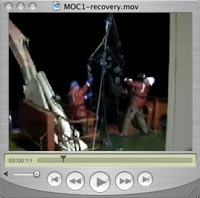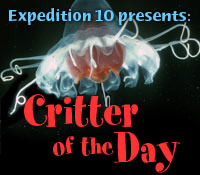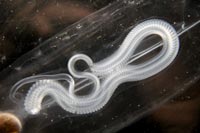|
  View Quicktime video » View Windows Media Player »  Today's Weather Sunny Latitude: 63 58.1 S Longitude: 66 50.70 W Wind: 25-30 KT Sea State: 6 Swell Height: 6-8 Baro Pressure: 981 mB Sea Surface Temp: 3.3 °C Vis: 10+ nautical miles 
  Check out the new Hot Topic! The Watery World of Salps March 1 , 2006 by Kate Madin Ask anyone who works at sea, and they’ll tell you: unexpected and dangerous things happen. Seas get rough and decks slippery, equipment or instruments fail, wires break and your equipment sinks to the bottom of the sea. There’s no sure way to predict; you have to be alert and prepared. Last night, something happened that could have turned out much worse, except for the way seagoing people worked together. The MOCNESS net was coming up from 500 meters (1,500 ft), the wire being pulled by the winch. Third mate Dave Morse was controlling the Gould. Seaman Elfren Prado was on the winch. At 10 p.m., Elfren called Eric Hutt, the MPC, in his office, saying “there’s something wrong with the wire!” The winch wire is routed up and over the block (the pulley, which guides the wire) and down to the net in the water. Suddenly the wire ran down, not up. MT Jamee called Eric: “the block is gone!” It broke off and slid down the wire to the water. Erich Horgan, overseeing the tows, heard the calls and ran, too. Soon, everyone knew. With 10-foot seas washing over the deck, and 30-knot winds, the wire—under enormous tension from pulling the net—now ran over the rail instead of over the pulley, scraping back and forth each time the ship rocked, weakening the wire. We could lose MOCNESS. If people had been on deck, the falling block could have seriously hurt someone. Even now the wire could snap and recoil with great force. Captain Flanagan, Erich Horgan, Eric Hutt, Jamee and MST (Marine Science Technician) Eddie formed a plan to retrieve the net. They snapped a temporary pulley on the wire, hooked the crane to the pulley, and clipped ropes to the net frame. Eddie reached over the rail to grab the block, and the captain lost his hard hat catching the line. On the radio, Jamee coordinated the winch and crane, and everyone held ropes. David Morse guided the ship so that the wire was where the team needed. “It’s very difficult to position a ship, moving slowly, in high wind and seas—and at night,” said Erich, “so the net doesn’t drift near the propeller.” “It was amazing how quickly they got it under control,” said Diane, on the watching MOC team—“how quickly they a made it a safe environment for everyone to do what had to be done. They were focused and methodical, and did everything in steps to retrieve the net.” “We all used our experience and looked out for each other,” Erich commented afterwards. “People were constantly checking the space around them, to make sure everyone was safe while doing this.” Someone else, relieved, said, “it was as good as it could have been.”
Read the new interview
|
|||||||||||||||||||||||||||||||||||||||||||||||||||||||||||||||||||||||||||||||||||||||||||||
Mailing List | Feedback | Glossary | For Teachers | About Us | Contact
© 2010 Dive and Discover™. Dive and Discover™ is a registered trademark of Woods
Hole Oceanographic Institution

